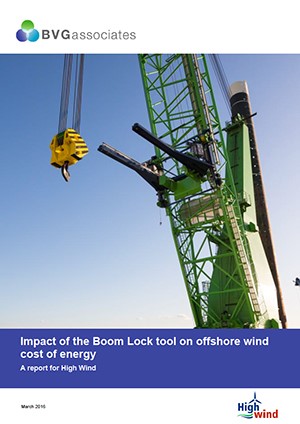
BVG Associates has recently analysed the effects of increasing the wind speed limit for turbine component lifts. The results of this analysis are described in detail in a new report, “Impact of the Boom Lock tool on offshore wind cost of energy”.
The report, available exclusively on this site, quantifies the impact on levelised cost of energy (LCOE) of reduced vessel use and earlier power generation, based on the use of the “Boom Lock” tool.
The report concludes that reducing weather sensitivity of turbine component lifting significantly reduces LCOE.
Demand for cost reduction
The main author of the report, Alun Roberts, Senior Associate at BVG Associates highlights the importance of further cost reductions for offshore wind to become a truly sustainable industry. He says:
“An important area for progress is to reduce the sensitivity of installation to the weather. For turbine installation, the key constraint is wind speed with most projects unable to lift components in more than 11m/s at hub height. Any increase in this maximum will have significant positive effects on the LCOE.”
The report was commissioned by High Wind, the developer and owner of the Boom Lock tool. The Boom Lock tool allows an offshore crane to install wind turbine components at high wind speeds by stabilising the hook during critical points in the lift.
Johan Heiler, General Manager of High Wind, says:
“Lifting major components in high winds is one of the biggest challenges facing the offshore wind industry. The lifting tools used in the offshore wind industry today are incremental evolutions of technologies that have been moved from onshore to offshore. If we are to really bring more predictability to lifting processes, there needs to be some different thinking. This report highlights the significant positive impacts such innovations can bring.”
Download the report
Find out more about High Wind
Find out more about BVG Associates
Like this post? Subscribe now and get notified about new content!





